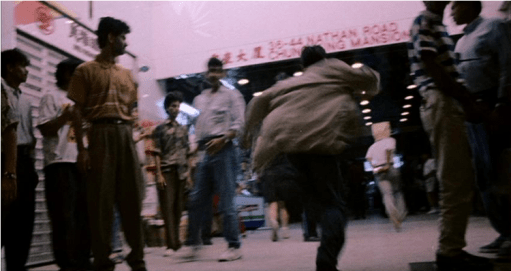The other side of Chungking Express
By Natalie Kwong, on 28 July 2020
Part of the MSc Environment & Sustainable Development Insights from Practice blog series.
Wong Kar-Wai’s Chungking Express, a 1994 film telling two stories of romantic longing is amongst one of my favourite films for its poetic storytelling and arthouse cinematography. A large portion of the film is set in the background of Chungking Mansions, from which its title derives from, depicted in the film as a hyperactive and eclectic mix of cultures (majority South Asian), but also as a crime hotspot for drug trade, scammers and immigrants. Having rewatched the film recently and coupled with the resurgence of the black lives matter movement has led me to reflect personally on my own experiences with racial inequality in Hong Kong, particularly the South Asian community, and ultimately how this leads to epistemic injustices.
The term ‘epistemic injustices’ was first introduced by Fricker (2007), in reference to injustices in someone’s capacity as a knower. Fricker makes a distinction between two different types of epistemic injustices:
- Hermeneutic Injustice—when someone lacks the resources, usually of conceptual nature required to formulate their problems;
- Testimonial Injustice—when someone is treated as lacking credibility due to a systemic identity prejudice which influences the listener.
The basis of this blog will focus on testimonial injustice, where the racial stereotypes attributed to the South Asian community in Hong Kong (a majority Chinese ethnic society) has led to the production and reproduction of epistemic injustices.
So how does this relate to the film Chungking Express? In the film, the stereotype of South Asians as criminals becomes reinforced as Chungking Mansions, a large hub for ethnic minorities, is depicted as a site of gang activity and violence. This homogenous depiction of South Asians in the building obfuscates an authentic representation of its community—the other side of Chungking Mansions is an agglomeration of traders, businesses, restaurants operated by South Asians and Africans. Having been inside the building myself on numerous occasions as part of volunteer work to cook for refugees and asylum seekers, I know it to be a site of rich and diverse stories, far from what is depicted in the film.
This depiction of South Asians is not only limited to Chungking Express, where the representation of these minorities in local TV and film are largely negative as they are used to serve comedic relief and villainous intent, perpetuating stereotypes and their exclusion from mainstream society. These depictions manifest as epistemic injustices on an institutional and structural level. For instance, children of South Asian minorities who attend local schools in Hong Kong aren’t offered language assistance when learning Chinese, putting them at a disadvantage to their peers who are able to practise Chinese at home. As a result of this language barrier, they become victims of epistemic injustices where their knowledge becomes unheard and face significant disadvantages in accessing livelihood and economic opportunities.
A clear instance of the epistemic injustices borne on these communities was in the shooting of a Nepalese man in 2009 by the police, which disturbingly mirrors the police aggression that reignited the recent black lives matter movement. The police had emphasised the man as a “dark-skinned foreigner with criminal convictions”, and ultimately authorities deemed the shooting as lawful and as an act of self-defence (SCMP, 2011). The family of the Nepalese man were denied judicial review of his death, despite citing a lack of police transparency in the case. The injustice on whose knowledge comes to matter in these cases becomes manifested on an institutional level as there is a clear privileging on whose knowledge becomes heard. Clearly, depictions of South Asians as barbaric and criminals in media reinforce these stereotypes that lead to epistemic injustices on a structural and institutional level.
This depiction of Chungking Mansions, and by extension South Asians, carries on to epistemic injustices that are reflected on an interpersonal level as well. Within my immediate and extended family and amongst friends, there is a prejudice held against this site—a place to be avoided due to its preconceived association with crime. On a personal level, looking back on my visits to the building for volunteer work, I was afraid to venture into the place alone and had tried to avoid eye contact when navigating the halls. Despite conflicting with my firmly held beliefs on racial equality, as Cunliffe (2019) has examined, these stereotypes as portrayed in the media operates on an unconscious level, existing in the social imagination and feed into judgements without express authorisation.
So how can this process of production and reproduction of epistemic injustices be challenged? In the same way that mainstream media perpetuates stereotypes, media can also be used to co-produce actionable knowledge through inclusive representation that challenges these injustices. Cunliffe (2019) identified four ways in which narrative fiction can help counter testimonial injustices: Firstly, through familiarisation, where inclusion of marginalised groups help acquaint an audience; Secondly, by stimulating a higher self awareness in the audience; Thirdly, in emphasising ambiguity in making decisive judgements about people; and finally, through representation of marginalised groups. As such, these processes require a co-production of knowledge, wherein those who have been marginalised become creators of such media. Jordan Peele’s Get Out serves as a prime example in challenging homogenous depictions of African Americans in mainstream media. The film depicts the microaggressions of racism in American society, in instances such as forced mentions of Barack Obama and Tiger Woods by white partygoers to the protagonist. This presentation of an African-American man’s experience in America by an African-American writer allows the audience to imagine oneself in the protagonist’s place, enabling a self awareness to recognise and question their own judgements in relation to epistemic injustices.
To return to a more personal level in my experience of epistemic injustices of South Asians in Hong Kong, the inclusion of South Asians in the production of mainstream media can allow for authentic representations of lived experiences, challenging the systemic racial stereotypes of these groups and the testimonial injustices associated. In essence, though media is not the singular approach in addressing these issues, the co-production of inclusive representation will be instrumental in confronting the “other side” of Chungking Express.
REFERENCES
Cottle, S. (2000). Ethnic Minorities and the Media: Changing Cultural Boundaries. Philadelphia: Open University Press.
Cunliffe, Z. (2019). Narrative Fiction and Epistemic Injustice. The Journal of Aesthetics and Art Criticism, 77(2). pp.169-182.
Fricker, M. (2007). Epistemic Injustice: Power and the Ethics of Knowing. Oxford: Oxford University Press.
South China Morning Post. (2011). ‘Review of Nepali’s shooting denied,’ South China Morning
Post, Hong Kong, 12 June. Available at: https://www.scmp.com/article/736380/review-nepalis-shooting-denied. [Accessed 11 June 2020].
2 Responses to “The other side of Chungking Express”
- 1
-
2
Akari Minami wrote on 13 November 2024:
An insightful and thought-provoking analysis! The exploration of epistemic injustices through media representation is powerful. Challenging stereotypes and promoting inclusive narratives are crucial steps toward greater social understanding and equality.
 Close
Close






I finished watching the movie just a while ago. And then Googled “Chungking express portrayal of Indians” and it led me to this article.
While watching the movie I felt that all South Asian characters didn’t have any proper dialogue. They were mostly repeating the same lines in Hindi over and over again.
They were turned into “minions” in the movie. They were stripped of complex realistic personalities. The lens barely spends time on them, they were just there to make people realize that the location being shown is a diverse one. For a long time, I thought the movie was shot in Singapore because of so many South Asians among East Asians.
It could be two things. One is that all those South Asians who were featured in the movie were real residents who were not actors and thus were given single-sentence dialogues and meager roles. Or it could be that, like you mentioned, the camera and direction of the movie acquired the attitude where one simply learns to keep them in the periphery without making eye contact.